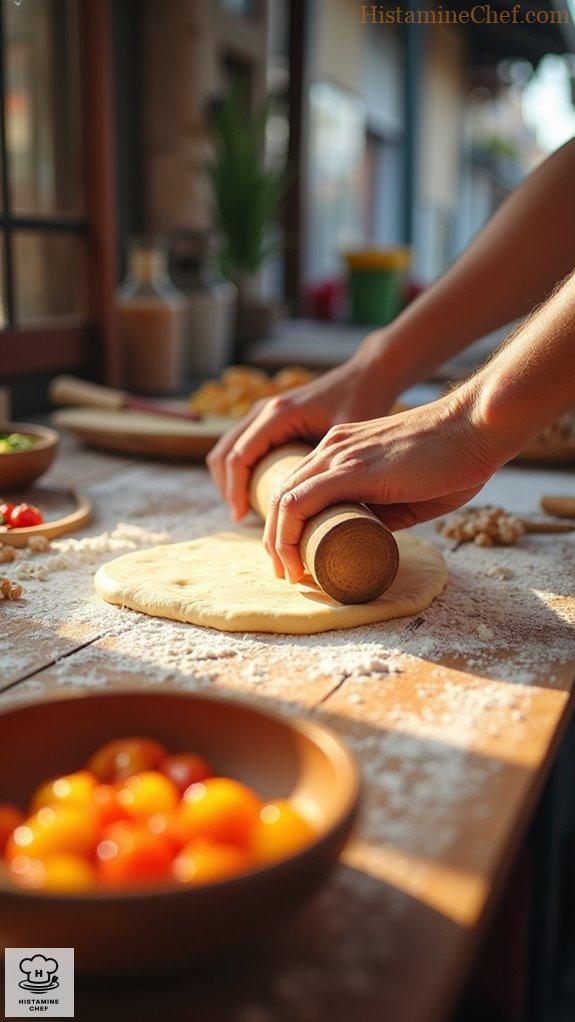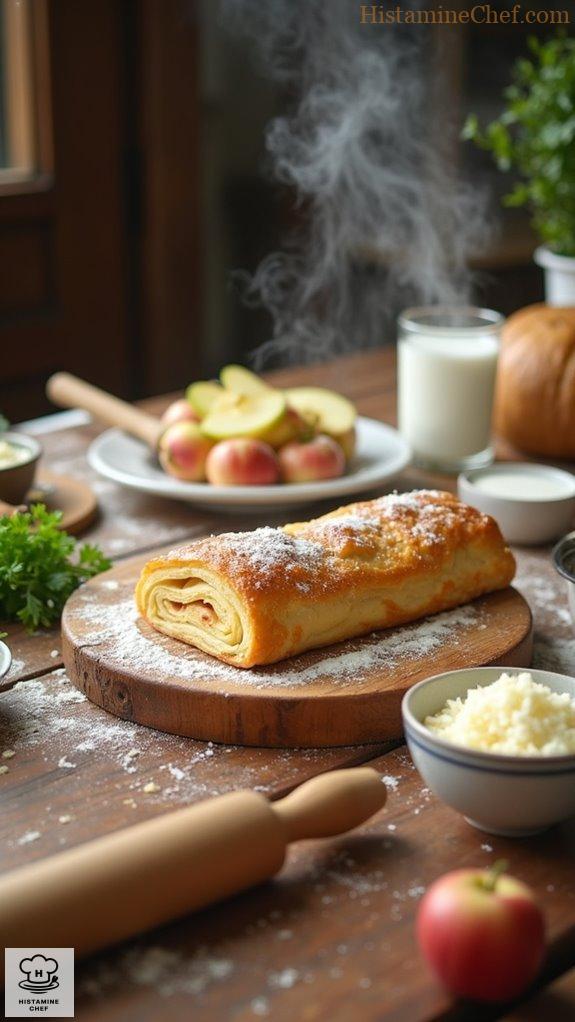Ever dreamt of biting into a warm, flaky strudel that doesn’t leave you feeling like you’ve eaten a histamine bomb? I’ve got your back! Envision rolling out thin layers of dough and filling them with juicy pears instead of apples—the perfect low-histamine twist! With just flour, water, and a pinch of salt, it’s that easy. Trust me, your taste buds will dance with delight. Curious about how to get it just right? Hang tight, there’s more to explore!
Historic Streets of Berlin

Berlin’s historic streets not only serve as a tapestry of the city’s past but also as vibrant venues for its contemporary street food culture. Emerging from the rich culinary traditions influenced by various immigrant populations over the decades, Berlin’s street food scene reflects the city’s diversity and innovation.
Vendors line the iconic Unter den Linden boulevard, where the mingling of historical and modern elements creates an inviting atmosphere. The development of street food in Berlin can be traced back to the early 20th century, when local vendors began selling traditional snacks like currywurst and döners, coinciding with urban expansion and the inclusion of fresh ingredients from market squares. Today, the city’s food markets and festivals celebrate this culinary heritage — from Turkish kebabs to Vietnamese pho — which exemplifies Berlin’s open-minded spirit. Notably, the Brandenburg Gate not only signifies reunification but also stands as a symbol of the vibrant street life that flourishes around it.
Street food not only provides a convenient dining option for busy residents and tourists but also fosters community through shared culinary experiences, transforming the historic streets into gastronomic hubs that honor both tradition and contemporary creativity.
As a result, dining along these storied thoroughfares becomes a delicious journey through Berlin’s multifaceted culture, echoing the city’s developing character.
Street-Side Pastry Rolling التجهيز

Street vendors preparing Street Style Strudel often start by rolling out thin layers of dough right on their carts.
They generously flour the surface to avoid sticking and use a sturdy rolling pin to create elastic sheets, ensuring consistent thickness.
These vendors master the technique of lifting and rotating the dough with finesse, adjusting flour as necessary to prevent sticking.
Once thin enough, they spread a filling of fruits or nuts before carefully rolling the strudel and placing it in a hot oven or on a griddle to achieve a crisp, golden finish.
The aroma wafts through the air, drawing in customers enthusiastic to try this delightful delicacy.
Ingredients Needed:
- 2 cups all-purpose flour
- 1/2 cup water
- 1/4 cup vegetable oil
- 1 tablespoon vinegar
- 1/2 teaspoon salt
- 2 cups fruit filling (apples, cherries, or berries)
- 1/2 cup sugar
- 1 teaspoon cinnamon
Cooking Steps:
- Mix flour, salt, water, oil, vinegar.
- Knead until smooth and elastic.
- Chill dough for 30 minutes.
- Roll out dough until thin.
- Spread filling evenly over dough.
- Roll dough tightly into logs.
- Bake in a preheated oven.
- Serve warm, dusted with powdered sugar.
Homemade Low-Histamine Pastry

To make a homemade low-histamine strudel, start by preparing the pastry dough using allowed ingredients.
Combine flour (such as spelt or gluten-free alternative), water, and a pinch of salt; knead until smooth and let it rest for at least 30 minutes.
Roll the dough as thin as possible, then fill it with low-histamine fruits like apples or pears, mixed with a bit of sugar and allowed sweeteners for taste.
Carefully roll the pastry and place it seam-side down on a baking sheet lined with parchment paper.
Bake in a preheated oven at 375°F (190°C) for about 30 minutes or until golden brown, allowing it to cool slightly before serving.
- Use allowed flour (spelt, etc.)
- Roll dough very thin
- Fill with allowed fruits
- Add sugar and sweeteners
- Bake until golden brown
- Serve warm, dusted with sugar
- Enjoy fresh, don’t store
Low Histamine Variation of Strudel

Street food is often flavorful and diverse, but it can pose challenges for individuals with histamine intolerance. This intolerance requires careful selection of ingredients to avoid triggers that can exacerbate symptoms. Many traditional street food items incorporate high histamine ingredients or liberators, making them unsuitable for those who are sensitive.
Eating street food like strudel can be problematic for those with histamine intolerance due to ingredients that are high in histamine or that liberate histamine, such as certain fruits and processed elements. The SIGHI list indicates that foods like fermented dairy, certain fruits, and specific spices can be restricted. Consequently, indulging in such street foods may lead to uncomfortable symptoms due to the histamine content. Delicious low-histamine alternatives can be incorporated to make these dishes more suitable.
Instructions for Low Histamine Strudel:
- Use allowed fruits like apple or pear instead of restricted options.
- Substitute traditional dairy with almond or coconut milk for the filling.
- Replace any fermented or aged cheeses with young cheeses if used.
- Select fresh, pure meats or avoid adding processed meats entirely.
- Use allowed oils like coconut oil for greasing the baking pan.
- Roll out dough using wheat flour as tolerated or opt for spelt flour.
- Avoid adding spices like cinnamon if they’re restricted per sensitivity.
- Confirm that all vegetables used are on the allowed list.
- Bake at a moderate temperature to avoid burning the ingredients.
- Serve warm and fresh, as reheating can increase histamine levels.
Video Summary
Strudel has a fascinating history, originating in the Austro-Hungarian Empire. In this video, we’ll also present a home-friendly, low histamine version later on.
Street vendors prepare strudel by layering thin pastry sheets filled with a luscious fruit filling, typically using apples or cherries. They start by preparing dough from flour, water, and a pinch of salt. The dough is rolled out thinly on a floured surface, stretched gently to achieve a paper-thin consistency.
Meanwhile, they peel and slice fresh apples, mixing them with sugar and cinnamon for flavor. The vendors then spread the apple filling over the dough, leaving an edge for sealing. After adding a sprinkle of breadcrumbs to absorb moisture, they carefully roll up the pastry, forming a log.
Before baking, the strudel is brushed with melted butter for a golden finish. It bakes at 180 degrees Celsius for about 30 minutes until perfectly crispy.
For the low histamine version, start by using spelt flour instead of regular flour for the dough. In place of apples, you could use pears for the filling, combined with a touch of honey for sweetness.
Avoid cinnamon and use nutmeg instead for a warm flavor. Instead of breadcrumbs, use ground oats to soak up moisture. Brush the rolled strudel with melted coconut oil instead of butter. Bake at the same temperature, keeping an eye out for a golden crust.
The final meal looks beautifully golden and tastes delightfully sweet with a hint of spice. Click the link in the description for the full recipe.
Questions and Answers
What Are Low-Histamine Alternatives to Traditional Strudel Fillings?
They say you can’t have your cake and eat it too, but I’ve found low-histamine alternatives like apple, blueberry, or pear for fillings. Let’s embrace deliciousness without sacrificing our health—my taste buds are thriving!
Can I Use Frozen Fruit for the Filling?
I’ve found frozen fruit works great for fillings! Just guarantee it’s compatible with your dietary needs. It saves time and still provides that delicious burst of flavor, making your treats both satisfying and convenient.
How Do I Store Leftover Strudel?
Did you know that 30% of food waste occurs at home? I store leftover strudel in an airtight container in the fridge, enjoying it within three days for the best flavor and texture. It’s a delicious treat!
Is It Safe to Freeze Low-Histamine Strudel?
Freezing low-histamine strudel can be safe, but I recommend wrapping it tightly to prevent freezer burn. When you’re ready to enjoy it, just thaw it in the fridge for best results. Enjoy!
What Are the Best Kitchen Tools for Making Strudel?
Creating culinary masterpieces requires the right tools. I swear by my rolling pin for dough perfection, a sharp knife for precise slicing, and a sturdy baking tray that transforms my ideas into mouthwatering reality. Let’s ignite your kitchen!
References
- https://us.trip.com/blog/map-of-berlin-historical-sites/
- https://www.visitberlin.de/en/berlin-city-map
- https://www.introducingberlin.com/map/
- https://www.the-berliner.com/berlin/historical-maps-of-berlin-from-1600-to-1920/
- https://streetwise.world/maps/berlin/
- https://smittenkitchen.com/2008/11/pie-crust-103-rolling-and-crimping/
- https://philshomekitchen.org/2023/08/22/the-swiss-roll-method-for-croissant-dough/
- https://www.harbourbreezehome.com/rolling-dough/
- https://www.goodthingsbydavid.com/2015/10/the-best-way-to-roll-out-cookie-dough.html


Leave a Reply